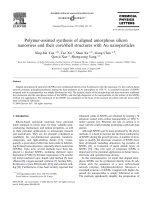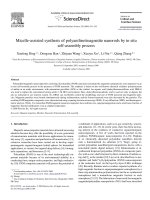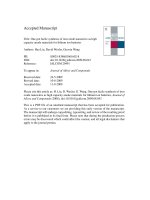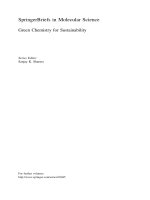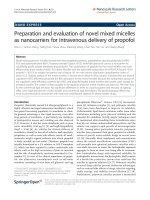Microwave assisted synthesis of novel thiazolidinone analogues as possible bioactive agents
Bạn đang xem bản rút gọn của tài liệu. Xem và tải ngay bản đầy đủ của tài liệu tại đây (486.9 KB, 6 trang )
Journal of Advanced Research (2012) 3, 325–330
Cairo University
Journal of Advanced Research
ORIGINAL ARTICLE
Microwave assisted synthesis of novel thiazolidinone
analogues as possible bioactive agents
Adithya Adhikari a, Balakrishna Kalluraya a,*, Kizhakke Veedu Sujith a,
Kuluvar Gouthamchandra b, Riaz Mahmood b
a
Department of Studies in Chemistry, Mangalore University, Mangalagangothri 574 199, Karnataka, India
Department of P.G. Studies and Research in Biotechnology and Bioinformatics, Jnanasahyadri, Kuvempu University,
Shankaraghatta 577 451, Karnataka, India
b
Received 30 August 2011; revised 20 October 2011; accepted 21 October 2011
Available online 3 December 2011
KEYWORDS
4-Thiazolidinone;
Solvent free reaction;
Microwave assisted synthesis;
Antioxidant;
Antibacterial;
Antifungal activity
Abstract A series of 5-{[(6-substituted-2-hydroxyquinolin-3-yl)methylidene]/5-[(7-substitutedtetrazolo[1,5-a]quinoline-4-yl)methylidene]}-2-[(4-substitutedphenyl)amino]-1,3-thiazol-4(5H)-one
was successfully synthesized under solvent free conditions by microwave irradiation in high yield.
Structures of these newly synthesized compounds were established on the basis of spectral and analytical data. These novel compounds were also evaluated for their in vitro antioxidant, antibacterial
and antifungal activity.
ª 2011 Cairo University. Production and hosting by Elsevier B.V. All rights reserved.
Introduction
The derivatives of 4-thiazolidinone nucleus have occupied a
unique place in the field of medicinal chemistry [1]. They display a wide range of biological activities like antibacterial [2],
* Corresponding author. Tel.: +91 9448824075; fax: +91 824
2287367.
E-mail address: (B. Kalluraya).
2090-1232 ª 2011 Cairo University. Production and hosting by
Elsevier B.V. All rights reserved.
Peer review under responsibility of Cairo University.
doi:10.1016/j.jare.2011.10.003
Production and hosting by Elsevier
anti-inflammatory [3] and anticancer [4]. They also have
nteresting activity profiles like serine/threonine-protein kinase
(PlK1) [5], cystic fibrosis transmembrane conductance regulator (CFTR) inhibitors [6].
Compounds containing quinoline motif are most widely used
as bio active agents [7,8]. Its derivative tetrazolo[1,5-a]quinoline
is a promising scaffold and is described as cytotoxic, dual nonacidic anti-inflammatory, antimicrobial agent [9,10] and even
recognized as inhibitor of hepatitis C virus (HCV) [11].
Microwave (MW) irradiation, an unconventional energy
source, has been used for a variety of applications including
organic synthesis, wherein chemical reactions are accelerated
because of selective absorption of MW energy. The application
of microwave irradiation in conjunction with the use of catalysts or mineral-supported reagents, under solvent-free conditions, enables organic reactions to occur expeditiously at
ambient pressure, thus providing unique chemical processes
with special attributes such as enhanced reaction rates and
higher yields [12,13].
326
A. Adhikari et al.
Prompted by these observation and in continuation of our
work on biologically potent heterocycles [14,15] we herein report
the synthesis and biological activity of a series of 5-{[(6-substituted-2-hydroxyquinolin-3-yl)methylidene]/[(7-substitutedtetrazolo[1,5-a]quinoline-4-yl)methylidine]}-2-[(4-substituted phenyl)amino]-1,3-thiazol-4(5H)-one under solvent free conditions
using microwave energy.
Experimental
Instruments and starting materials
Purity of the newly synthesized compounds was checked by
TLC on silica gel plates (Merck, Silica gel 60F254). Melting
points were determined in open capillary tubes and are uncorrected. Elemental analysis was carried out in Vario EL III Elementa model. IR spectra were recorded by dispersing the
compounds in KBr pellets on a Schimadzu FT-IR 157 spectrophotometer. 1H NMR spectra were recorded on a Bruker
Avance II 400 MHz NMR spectrometer and all the chemical
shift values were reported as d (ppm). 13C NMR spectra were
recorded on a Bruker Avance II 400 MHz NMR spectrometer.
Mass spectra were recorded on a Agilent 6320 ion trap LC/MS
instrument. Microwave reactions were carried out in Godrej
(GMC 20E 08 SSGX, 800 Watt, 2450 MHz) microwave oven.
The synthetic route for the title compounds is outlined in
Schemes 1 and 2. 7-Substituted tetrazolo[1,5-a]quinoline-4carbaldehyde (3a–c) and 6-substituted-2-hydroxyquinoline-3carbaldehyde (4a–c) were prepared by reacting 6-substituted2-chloro quinoline-3-carbaldehyde (2) with sodium azide in
DMF/4 M HCl under microwave irradiation. 2-[(4-Substitutedphenyl) amino]-1,3-thiazol-4(5H)-one (1a–b) was prepared
by the reaction of substituted phenylthiourea with monochloroaceticacid in presence of sodium acetate [16]. Reaction of
3a–c/4a–c with 1a–b gave the title compounds 5-[(6-substituted-2-hydroxyquinolin-3-yl)methylidene]-2-[(4-substitutedphenyl)amino]-1, 3-thiazol-4(5H)-one/5-[(7-substitutedtetrazolo[1,
5-a]quinoline-4-yl)methylidene]-2-[(4-substitutedphenyl)amino]1,3-thiazol-4(5H)-one in high yield.
Scheme 1
General procedure for the synthesis of 2-aryamino-4thiazolidinones (1a–b)
A mixture of aryl thiourea (0.1 mol) and fused sodium acetate
(16.4 g, 0.2 mol) was taken in absolute alcohol (100 mL) and
refluxed for 8 h. The excess of solvent was removed under reduced pressure. The contents were added to ice-cold water.
The precipitate so obtained was filtered, washed with distilled
water and recrystallized from ethanol. The compounds prepared according to this procedure are:
2-Phenylamino-4-thiazolidinone 1a : M.p. 178–179 °C (Lit
[16] M.p. 179 °C), yield 70%.
2-(4-Methyl)amino-4-thiazolidinone 1b : M.p. 178–180 °C
(Lit [16] M.p. 180 °C), yield 69%.
Synthesis of substituted tetrazolo[1,5-a]quinoline-4carbaldehyde (3a–c)
In a 100 mL beaker, 6-substituted-2-chloro-3-formyl quinolines (2) (0.01 mol) was dissolved in DMF (20 mL) and cooled.
To the clear solution sodium azide (1.3 g, 0.02 mol) was added
and the contents were subjected to MW irradiation (90 W) for
3 min. As the beaker was allowed to cool, silky solid material
precipitates out. It was poured to crushed ice (100 g), filtered,
dried and recrystallized from DMF.
Tetrazolo[1,5-a]quinoline-4-carbaldehyde 3a
M.p. 210 °C; yield 80%. – 1H NMR (DMSO-d6) d: 7.912 (m,
1H, Ar–H), 8.15 (m, 1H, Ar–H), 8.47 (d, 1H, J = 7.92 Hz,
Ar–H), 8.72 (d, 1H, J = 8.4 Hz, Ar–H), 9.02 (s, 1H, Py–H),
10.43 (s, 1H, CHO); – LC/MS: m/z = 199 (M++1). –
C10H6N4O (198): calcd. C 60.60; H 3.05; N 28.27; found C
60.54; H 3.01; N 28.21.
7-Methyltetrazolo[1,5-a]quinoline-4-carbaldehyde 3b
M.p. 213 °C; yield 82%. – 1H NMR (DMSO-d6) d: 2.31 (s, 3H,
CH3), 7.75 (s, 1H, Ar–H), 7.85 (d, 1H, J = 6.8 Hz, Ar–H),
Synthesis of quinoline analogues.
Rapid synthesis of bioactive thiazolidinone analogues
Scheme 2
327
Synthesis of novel thiazolidinone derivatives.
8.53 (d, 1H, J = 8.1 Hz, Ar–H), 9.12 (s, 1H, Py–H), 10.53 (s,
1H, CHO); – LC/MS: m/z = 213 (M++1). – C11H8N4O
(212): calcd. C 62.26; H 3.80; N 26.40; found C 62.19; H
3.71; N 26.33.
7-Methoxytetrazolo[1,5-a]quinoline-4-carbaldehyde 3c
M.p. 227 °C; yield 84%. – 1H NMR (DMSO-d6) d: 3.95 (s, 3H,
OCH3), 7.68 (d, 1H, J = 6.92 Hz, Ar–H), 7.91 (s, 1H, Ar–H),
8.56 (d, 1H, J = 7.92 Hz, Ar–H), 9.31 (s, 1H, Py–H), 10.79 (s,
1H, CHO); – LC/MS: m/z = 229 (M++1). – C11H8N4O2
(228): calcd. C 57.89; H 3.53; N 24.55; found C 57.78; H
3.46; N 24.48.
General method for the preparation of 6-substituted-2hydroxyquinoline-3-carbaldehyde (4a–c)
In a 250 mL beaker, 6-substituted-2-chloro-3-formylquinolines
(2) (0.01 mol) and HCl (35 mL, 4 M) was taken and subjected
to MW irradiation (120 W) for 6 min. The contents were
cooled to r.t. and poured into a beaker containing crushed
ice (100 g), filtered, dried and recrystallized from acetic acid.
2-Hydroxyquinoline-3-carbaldehyde 4a : M.p. 297 °C (Lit
[17] M.p. 298 °C).
6-Methyl-2-hydroxyquinoline-3-carbaldehyde 4b : M.p.
274 °C (Lit [17] M.p. 275 °C).
6-Methoxy-2-hydroxyquinoline-3-carbaldehyde 4c: M.p.
272 °C (Lit [17] M.p. 274 °C).
General procedure for the synthesis of 5-{[(6-substituted-2hydroxyquinolin-3-yl)methylidene]/[(7-substitutedtetrazolo[1,5-a]quinoline-4yl)methylidine]}-2-[(4-substituted
phenyl)amino]-1,3-thiazol-4(5H)-one
An equimolar mixture of 7-substituted tetrazolo[1,5-a]quinoline-4-carbaldehyde (3a–c)/6-substituted-2-hydroxyquinoline3-carbaldehyde (4a–c) (0.01 mol), anhydrous sodium acetate
(0.01 mol) and 2-[(4-substitutedphenyl)amino]-1,3-thiazol4(5H)-one (1a–b) (0.01 mol) was ground together in a mortar
using a pestle for uniform mixing. This mixture was taken in
a 50 mL beaker and subjected to MW irradiation (90 W).
The completion of the reaction was monitored using TLC.
The product obtained was poured into crushed ice, filtered,
washed with ethanol and recrystallized from DMF to give
compounds 5a–f and 6a–f.
5-[(Tetrazolo[1,5-a]quinoline-4yl)methylidine]-2-(phenylamino)-1,3-thiazol-4(5H)-one 5a
R = H, R1 = H; M.p. 275 °C; yield 93%. – IR (KBr):
m = 2983.6 (CAH), 1650.9 (C‚O), 1514.6 (C‚N) cmÀ1. –
1
H NMR (DMSO-d6): d = 7.11–8.64 (m, 10H, Ar–H), 11.84
(br, 1H, NH), 12.68 (s, 1H, CH‚C). – LC–MS: m/z
(%) = 373 (M++1). – C19H12N6OS (372): calcd. C 61.28;
H 3.25; N 22.57; S 8.61; found C 61.19; H 3.16; N 22.51; S
8.57.
5-[(Tetrazolo[1,5-a]quinoline-4yl)methylidine]-2-[(4-methylphenyl)amino]-1,3-thiazol-4(5H)-one 5b
R1 = H, R = CH3; M.p. 268 °C; yield 90%. – IR (KBr):
m = 2969.5 (CAH), 1655.2 (C‚O), 1525.7 (C‚N) cmÀ1. –
1
H NMR (DMSO-d6): d = 2.32 (s, 3H, CH3), 7.16–8.59 (m,
9H, Ar–H), 11.8 (br, 1H, NH), 12.53 (s, 1H, CH‚C). – LC–
MS: m/z (%) = 387 (M++1). – C20H14N6OS (386): calcd. C
62.16; H 3.65; N 21.75; S 8.30; found C 62.10; H 3.59; N
21.69; S 8.25.
5-[(7-Methyl-tetrazolo[1,5-a]quinoline-4yl)methylidine]-2(phenylamino)-1,3-thiazol-4(5H)-one 5c
R1 = CH3, R = H; M.p. 280 °C; yield 91%. – IR (KBr):
m = 2975.1 (CAH), 1661.5 (C‚O), 1531.3 (C‚N) cmÀ1. –
1
H NMR (DMSO-d6): d = 2.32 (s, 3H, CH3), 7.14–8.61 (m,
9H, Ar–H), 11.78 (br, 1H, NH), 12.61 (s, 1H, CH‚C). –
LC–MS: m/z (%) = 387 (M++1). – C20H14N6OS (386):
calcd. C 62.16; H 3.65; N 21.75; S 8.30; found C 62.12; H
3.56; N 21.67; S 8.22.
328
5-[(7-Methyl-tetrazolo[1,5-a]quinoline-4yl)methylidine]-2[(4-methylphenyl)amino]-1,3-thiazol-4(5H)-one 5d
R1 = CH3, R = CH3; M.p. 278 °C; yield 89%. – IR (KBr):
m = 2985.4 (CAH), 1659.3 (C‚O), 1528.5 (C‚N) cmÀ1. –
1
H NMR (DMSO-d6): d = 2.31 (s, 3H, CH3), 2.32 (s, 3H,
CH3), 7.13–8.59 (m, 8H, Ar–H), 11.81 (br, 1H, NH), 12.68
(s, 1H, CH‚C). – LC–MS: m/z (%) = 401 (M++1). –
C21H16N6OS (400): calcd. C 62.98; H 4.03; N 20.99; S 8.01;
found C 62.86; H 3.98; N 20.91; S 7.95.
5-[(7-Methoxy-tetrazolo[1,5-a]quinoline-4yl)methylidine]-2(phenylamino)-1,3-thiazol-4(5H)-one 5e
R1 = OCH3, R = H; M.p. 286 °C; yield 94%. – IR (KBr):
m = 2935.6 (CAH), 1657.2 (C‚O), 1532.4 (C‚N) cmÀ1. –
1
H NMR (DMSO-d6): d 3.97 (s, 3H, OCH3), 7.11–8.55 (m,
9H, Ar–H), 11.76 (br, 1H, NH), 12.65 (s, 1H, CH‚C). –
LC–MS: m/z (%) = 402.9 (M++1). – C20H14N6O2S (402):
calcd. C 59.69; H 3.51; N 20.88; S 7.97; found C 59.59; H
3.46; N 20.78; S 7.86.
5-[(7-Methoxy-tetrazolo[1,5-a]quinoline-4yl)methylidine]-2[(4-methylphenyl)amino]-1,3-thiazol-4(5H)-one 5f
R1 = OCH3, R = CH3; M.p. 289 °C; yield 93%. – IR (KBr):
m = 2920.1 (CAH), 1686.1 (C‚O), 1506.8 (C‚N) cmÀ1. – 1H
NMR (DMSO-d6): d 2.32 (s, 3H, CH3), 3.98 (s, 3H, OCH3),
7.26–8.57 (m, 8H, Ar–H), 11.75 (br, 1H, NH), 12.69 (s, 1H,
CH‚C). – LC–MS: m/z (%) = 415.0 (M+-1). – C21H16N6O2S
(416): calcd. C 60.56; H 3.87; N 20.18; S 7.70; found C 60.49; H
3.81; N 20.12; S 7.61.
5-[(2-Hydroxyquinolin-3-yl)methylidene]-2-(phenylamino)1,3-thiazol-4(5H)-one 6a
R1 = H, R = H; M.p. 301 °C; yield 93%. – IR (KBr):
m = 3211.4 (OAH), 2960.7 (CAH), 1661.3 (C‚O), 1520.8
(C‚N) cmÀ1. – 1H NMR (DMSO-d6): d = 7.06–8.15 (m,
10H, Ar–H), 11.56 (br, 1H, NH), 12.17 (s, 1H, CH‚C),
12.4 (br, 1H, OH). – 13C NMR (DMSO-d6): d = 115.14,
120.57, 122.45, 122.59, 125.16, 128.87, 129.21, 129.52, 131.81,
138.8, 139.86, 140.4, 160.84. – LC–MS: m/z (%) = 348
(M++1). – C19H13N3O2S (347): calcd. C 65.69; H 3.77; N
12.10; S 9.23; found C 65.61; H 3.69; N 12.01; S 9.17.
5-[(2-Hydroxyquinolin-3-yl)methylidene]-2-[(4methylphenyl)amino]-1,3-thiazol-4(5H)-one 6b
R1 = H, R = CH3; M.p. 299 °C; yield 86%. – IR (KBr):
m = 3221.5 (OAH), 2959.8 (CAH), 1652.8 (C‚O), 1524.6
(C‚N) cmÀ1. – 1H NMR (DMSO-d6): d = 2.32 (s, 3H,
CH3), 7.05–8.2 (m, 9H, Ar–H), 11.51 (br, 1H, NH), 12.11 (s,
1H, CH‚C), 12.36 (br, 1H, OH). – LC–MS: m/z (%) = 362
(M++1). – C20H15N3O2S (361): calcd. C 66.46; H 4.18; N
11.63; S,8.87; found C 66.38; H 4.11; N 11.9; S 8.80.
A. Adhikari et al.
H 4.18; N 11.63; S,8.87; found C 66.39; H 4.11; N 11.59; S
8.79.
5-[(6-Methyl-2-hydroxyquinolin-3-yl)methylidene]-2-[(4methylphenyl)amino]-1,3-thiazol-4(5H)-one 6d
R1 = CH3, R = CH3; M.p. 306 °C; yield 92%. – IR (KBr):
m = 3169.3 (OAH), 2985.4 (CAH), 1659.3 (C‚O), 1528.5
(C‚N) cmÀ1. – 1H NMR (DMSO-d6): d = 2.31 (s, 3H,
CH3), 2.32 (s, 3H, CH3), 7.03–8.10 (m, 8H, Ar–H), 11.57
(br, 1H, NH), 12.14 (s, 1H, CH‚C), 12.34 (br, 1H, OH). –
LC–MS: m/z (%) = 376 (M++1). – C21H17N3O2S (375):
calcd. C 67.18; H 4.56; N 11.19; S 8.54; found C 67.10; H
4.51; N 11.10; S 8.48.
5-[(6-Methoxy-2-hydroxyquinolin-3-yl)methylidene]-2(phenylamino)-1,3-thiazol-4(5H)-one 6e
R1 = OCH3, R = H; M.p. 307 °C; yield 95%. – IR (KBr):
m = 3149.3 (OAH), 2962.7 (CAH), 1671.2 (C‚O), 1518.7
(C‚N) cmÀ1. – 1H NMR (DMSO-d6): d 3.98 (s, 3H,
OCH3), 7.07–8.17 (m, 9H, Ar–H), 11.52 (br, 1H, NH), 12.17
(s, 1H, CH‚C), 12.35 (br, 1H, OAH). – LC–MS: m/z
(%) = 378 (M++1). – C20H15N3O3S (377): calcd. C 63.65;
H 4.01; N 11.13; S 8.50; found C 63.57; H 3.97; N 11.08; S
8.43.
5-[(6-Methoxy-2-hydroxyquinolin-3-yl)methylidene]-2-[(4methylphenyl)amino]-1,3-thiazol-4(5H)-one 6f
R1 = OCH3, R = CH3; M.p. 310 °C; yield 92%. – IR (KBr):
m = 3224.7 (OAH), 2928.6 (CAH), 1659.7 (C‚O), 1516.3
(C‚N) cmÀ1. – 1H NMR (DMSO-d6): d 2.31 (s, 3H, CH3),
3.97 (s, 3H, OCH3), 7.06–8.15 (m, 8H, Ar–H), 11.48 (br, 1H,
NH), 12.09 (s, 1H, CH‚C), 12.31 (br, 1H, OH). – LC–MS:
m/z (%) = 392 (M++1). – C21H17N3O3S (391): calcd. C
64.43; H 4.38; N 10.73; S 8.19; found C 64.39; H 4.31; N
10.65; S 8.11.
Biological evaluations
DPPH radical scavenging activity
The procedure of Brand-Williams et al. [18] was followed for
evaluation of the free radical-scavenging capacity. Briefly,
1 mL of the test sample (100 lg/mL) was mixed with the methanolic 2,2-diphenyl-1-picrylhydrazyl (DPPH) solution (2 mL,
0.2 mM). The absorbance was measured at 517 nm immediately after standing at room temperature for 30 min. The percentage of scavenging has been calculated as the ratio of the
absorption of the sample relative to the control DPPH
(0.2 mM) solution without the test samples. DPPH radicalscavenging activity was expressed as the inhibition percentage.
Results are shown in Table 1.
5-[(6-Methyl-2-hydroxyquinolin-3-yl)methylidene]-2-(4phenylamino)-1,3-thiazol-4(5H)-one 6c
Antibacterial activity
R1 = CH3, R = H; M.p. 304 °C; yield 89%. – IR (KBr):
m = 3159.3 (OAH), 3001.1 (CAH), 1669.1 (C‚O), 1510.4
(C‚N) cmÀ1. – 1H NMR (DMSO-d6): d = 2.36 (s, 3H,
CH3), 7.07–8.08 (m, 9H, Ar–H), 11.54 (br, 1H, NH), 12.10
(s, 1H, CH‚C), 12.37 (br, 1H, OH). – LC–MS: m/z
(%) = 362 (M++1). – C20H15N3O2S (361): calcd. C 66.46;
The newly synthesized compounds were screened for their antibacterial activity against Escherichia coli, Staphylococcus aureus
and Pseudomonas aeruginosa using Agar well diffusion method
[19]. In this method, 24 h old Muller–Hinton broth cultures of
test bacteria were swabbed uniformly on solidified sterile
Muller–Hinton agar plates using sterile cotton swab. Then,
Rapid synthesis of bioactive thiazolidinone analogues
Table 1 DPPH radical scavenging assay for the compounds
5a–f/6a–f.
Compd No.
% Inhibition at 100 lg/mL ± SEMa
5a
5b
5c
5d
5e
5f
6a
6b
6c
6d
6e
6f
BHT
78.5 ± 0.64
76.5 ± 0.58
89.0 ± 0.66
79.6 ± 0.52
79.1 ± 0.66
82.1 ± 0.74
80.2 ± 0.68
82.0 ± 0.72
92.1 ± 0.86
81.7 ± 0.71
84.5 ± 0.84
83.1 ± 0.76
91.3 ± 1.11
a
329
zones of inhibition of fungal growth. Metronidazole was used
as standard. The complete antifungal analysis was carried out
under strict aseptic conditions. The results are summarized in
Table 2.
Determination of minimum inhibitory concentrations (MICs)
A serial dilution was carried out to give final concentrations
between 1.5 and 50.00 lg/mL of the test samples. The tubes
were inoculated with 20 lL of the bacterial suspension per
mL nutrient broth, homogenized and incubated at 37 °C.
The MIC value was determined as the lowest concentration
of the test samples in the broth medium that inhibited the visible growth of the test microorganism [21].
Statistical analysis
Data represents mean ± S.E.M. of triplicate analysis.
aseptically wells of 6 mm diameter were bored in the inoculated
plates with the help of gel puncher and the samples (100 lL),
standard (Amoxicillin, 100 lL) and control (DMSO) were
added into the labelled wells. The plates were incubated at
37 °C for 24 h in upright position and the zone of inhibition
was recorded. Experiments were done at concentrations of 100
and 50 lg/mL of the test samples. The results are summarized
in Table 2.
The results of these experiments were expressed as
mean ± S.E. of six animals in each group. The data were evaluated by one way analysis of variance (ezANOVA) followed
by Tukey’s pair-wise comparison test. The values of
P < 0.05 and P < 0.01 were considered as statistically
significant.
Results and discussion
Chemistry
Antifungal activity
The antifungal activity was carried out against the fungi Candida albicans, Aspergillus flavus by agar well diffusion method
[20]. The cultures of 48 h old grown on potato dextrose agar
(PDA) were used for inoculation of fungal strain on PDA
plates. An aliquot (0.02 ml) of inoculum was introduced to
molten PDA and poured into a petri dish. After solidification, the appropriate wells were made on agar plate by using
cork borer. Incubation period of 24–48 h at 28 °C was maintained for observation of antifungal activity of the compounds. The antifungal activity was evaluated by measuring
Table 2
Antibacterial and antifungal activity of compounds 5a–f/6a–f.
MIC lg/mLa
Compd.
5a
5b
5c
5d
5e
5f
6a
6b
6c
6d
6e
6f
Standard
Control
a
The current investigation describes the convenient synthesis of
starting compounds 7-substituted tetrazolo[1,5-a]quinoline4-carbaldehyde (3a–c) and 6-substituted-2-hydroxyquinoline3-carbaldehyde (4a–c) under microwave energy in high yield.
Also when these were subjected to react with 2-[(4-substitutedphenyl)amino]-1,3-thiazol-4(5H)-one (1a–b) under solvent free
conditions using microwave energy, successfully yielded 5-[(6substituted-2-hydroxyquinolin-3-yl)methylidene]-2-[(4-substitutedphenyl)amino]-1,3-thiazol-4(5H)-one (5a–f) and 5-[(7-substitutedtetrazolo[1,5-a]quinoline-4-yl)methylidene]-2-[(4-substitutedphenyl)amino]-1,3-thiazol-4(5H)-one (6a–f) in short time. This
E. coli
P. aeruginosa
S. aureus
C. albicans
A. flavus
16.5 ± 2.6
18.0 ± 2.8
24.5 ± 3.2
18.5 ± 2.4
17.0 ± 2.2
14.5 ± 1.6
19.0 ± 1.8
16.5 ± 2.0
38.0 ± 3.8
34.5 ± 3.6
14.0 ± 1.6
15.5 ± 1.8
8.5 ± 0.5
0
19.0 ± 2.6
36.5 ± 3.4
38.0 ± 3.2
17.5 ± 2.8
15.5 ± 2.4
17.0 ± 1.8
15.0 ± 2.8
14.5 ± 2.2
12.5 ± 1.8
14.0 ± 2.4
18.5 ± 2.6
19.0 ± 2.2
10.1 ± 1.2
0
37.5 ± 2.8
36.0 ± 3.1
38.0 ± 2.6
21.0 ± 2.2
19.5 ± 2.1
32.0 ± 2.8
32.5 ± 2.6
36.5 ± 2.8
38.0 ± 3.2
36.0 ± 3.4
32.5 ± 2.8
34.0 ± 3.1
12.0 ± 1.6
0
16.0 ± 1.8
19.5 ± 2.6
34.0 ± 3.2
12.6 ± 1.8
18.0 ± 2.0
14.0 ± 2.6
19.0 ± 2.2
16.5 ± 1.6
38.5 ± 3.8
19.0 ± 1.8
16.5 ± 2.2
36.5 ± 3.6
10.5 ± 1.6
0
19.0 ± 2.2
20.0 ± 2.0
40.0 ± 4.1
19.5 ± 2.2
38.5 ± 4.2
18.5 ± 2.4
20.5 ± 2.8
19.5 ± 2.4
38.0 ± 4.1
38.6 ± 3.6
22.0 ± 2.8
32.5 ± 3.2
14.5 ± 2.2
0
Data represents mean ± S.E.M. of triplicate analysis.
330
A. Adhikari et al.
method is unique, rapid and convenient for the synthesis of
novel compounds.
[5]
Pharmacology
Test samples 5a–f/6a–f were screened for their free radical
scavenging activity by DPPH method. Antioxidant reacts with
DPPH, which is a stable free radical and converts it to
1,1-diphenyl-2-picrylhydrazine. The degree of discoloration
indicates the scavenging potentials of the antioxidant compounds. At the concentration of 100 lg, compounds 5c and
6c display the highest activity which is comparable with the
standard butylated hydroxytoluene (BHT).
During the antibacterial and antifungal screening of the
compound 5a–f/6a–f strict aseptic conditions were followed.
Among the compounds tested 5f and 6e showed good antibacterial activity where as compound 5a, 5d, 5f and 6b displayed
good antifungal activity at 100 lg/mL. All the results are presented in Table 2.
[6]
[7]
[8]
[9]
Conclusion
[10]
Synthesis of heterocyclic compounds like thiazolidinones and
their derivatives generally involve prolonged reaction conditions. So herein we report a microwave mediated green synthesis
of the title compounds in good yield. Also antioxidant results
justify the use of compound 5a–f/6a–f as efficient radical scavengers as all the compounds demonstrate significant activity.
Among them compound 5c and 6c displayed highest activity
which is equivalent to the standard. Apart from that some of
the compounds also displayed significant antibacterial and antifungal activity. Thus on the basis of these results it can be concluded that the compounds bearing thiazolidinones along with
tetrazol[1,5-a]quinoline/hydroxylquinolines constitute novel
bio molecules of significant pharmacological importance.
[11]
[12]
[13]
[14]
[15]
Acknowledgement
One of the authors A.A. thanks University Grant Commission,
New Delhi, for the financial assistance in the form of fellowship.
[16]
[17]
Appendix A. Supplementary material
[18]
Supplementary data associated with this article can be found,
in the online version, at doi:10.1016/j.jare.2011.10.003.
[19]
References
[1] Verma A, Saraf SK. 4-Thiazolidinone- a biologically active
scaffold. Eur J Med Chem 2008;43(5):897–905.
[2] Khan SA, Yusuf M. Synthesis and biological evaluation of some
thiazolidinone derivatives of steroid as antibacterial agents. Eur
J Med Chem 2009;44(6):2597–600.
[3] Uchoˆa FDT, Cattani VB, Lima MCA, Galdino SL, Pitta IR,
Costa TD. Development and application of LC-UV method for
the quantification of the anti-inflammatory thiazolidinone PG15
in rat plasma. J Braz Chem Soc 2008;19:1553–9.
[4] Zhou H, Wu S, Zhai S, Liu A, Sun Y, Li R, et al. Design,
synthesis, cytoselective toxicity, structure–activity relationships,
[20]
[21]
and pharmacophore of thiazolidinone derivatives targeting
drug-resistant lung cancer cells. J Med Chem 2008;51(5):1242–51.
Santamaria A, Neef R, Eberspa U, Eis K, Husemann M,
Mumberg D, et al. Use of the novel Plk1 inhibitor ZKthiazolidinone to elucidate functions of Plk1 in early and late
stages of mitosis. Mol Biol Cell 2007;18(10):4024–36.
Ma T, Thiagarajah JR, Yang H, Sonawane ND, Folli C,
Galietta LJV, et al. Thiazolidinone CFTR inhibitor identified
by high-throughput screening blocks cholera toxin-induced
intestinal fluid secretion. J Clin Invest 2002;110(11):1651–8.
Phan LT, Jian T, Chen Z, Qiu YL, Wang Z, Beach T, et al.
Synthesis and antibacterial activity of a novel class of 4’substituted 16-membered ring macrolides derived from tylosin. J
Med Chem 2004;47(12):2965–8.
Vargas LY, Castelli MV, Kouznetsov VV, Urbina JM, Lopez
SN, Sortino M, et al. In vitro antifungal activity of new series of
homoallylamines and related compounds with inhibitory
properties of the synthesis of fungal cell wall polymers. Bioorg
Med Chem 2003;11(7):1531–50.
Bekhit AA, El-Sayed OA, Al-Allaf TAK, Aboul-Enein HY,
Kunhi M, Pulicat SM, et al. Synthesis, characterization and
cytotoxicity evaluation of some new platinum(II) complexes of
tetrazolo[1,5-a]quinolines. Eur J Med Chem 2004;39(6):499–505.
Kategaonkar AH, Pokalwar RU, Sonar SS, Gawali VU,
Shingate BB, Shingare MS. Synthesis, in vitro antibacterial and
antifungal evaluations of new a-hydroxyphosphonate and new
a-acetoxyphosphonate derivatives of tetrazolo[1, 5-a]quinoline.
Eur J Med Chem 2010;45(3):1128–32.
Thota S, Argade A, Singh R, Lu HH, Huang P. Inventor; Reigal
Pharmaceuticals Inc., assignee. HCV Inhibitors and methods of
using them. United States Patent 7358,259 B2; 2008.
Varma RS. Solvent-free organic syntheses using supported
reagents and microwave irradiation. Green Chem 1999;1:43–55.
Larhed M, Hallberg A. Microwave-assisted high-speed
chemistry: a new technique in drug discovery. Drug Disc
Today 2001;6(8):406–16.
Sujith KV, Rao JN, Shetty P, Kalluraya B. Regioselective
reaction: synthesis and pharmacological study of Mannich bases
containing ibuprofen moiety. Eur J Med Chem 2009;44(9):
3697–702.
Ramaprasad GC, Kalluraya B, Sunil Kumar B, Hunnur RK.
Synthesis and biological property of some novel 1,3,4oxadiazoles. Eur J Med Chem 2010;45(10):4587–93.
Hegde JC. Some contribution to the chemistry of mesoionoc
compounds [dissertation]. Mangalore University; 2005.
Kalluraya B, Gururaja R, Rai G. One Pot Reaction; Synthesis,
Characterization and biological activity of 3-alkyl/aryl-9substituted-1,2,4-triazolo[3,4-b][1,3,4]quinolino thiadiazepines.
Indian J Chem 2003;42B:211.
Brand-Williams W, Cuvelier ME, Berset C. Use of a free radical
method to evaluate antioxidant activity. LWT-Food Sci Tech
1995;28(1):25–30.
Tepe B, Donmez E, Unlu M, Candan F, Daferera D, VardarUnlu Polissiou GM, et al. Antibacterial and antioxidative
activities of the essential oils and methanol extracts of Salvia
cryptantha (Montbret et Aucher ex Benth) and Salvia multicaulis
(Vahl). Food Chem 2004;84:519–25.
Perez C, Pauli A, Bazerque P. An antibiotic assay by the agarwell method. Acta Biol Med Exp 1990;15:113–5.
National Committee for Clinical Laboratory Standards (USA).
Methods for dilution antimicrobial susceptibility tests for
bacteria that grow aerobically, 3rd ed. NC-275 CLS,
Approved standard. NCCLS document M100-S12. Wayne
(Pennsylvania); 2002.

